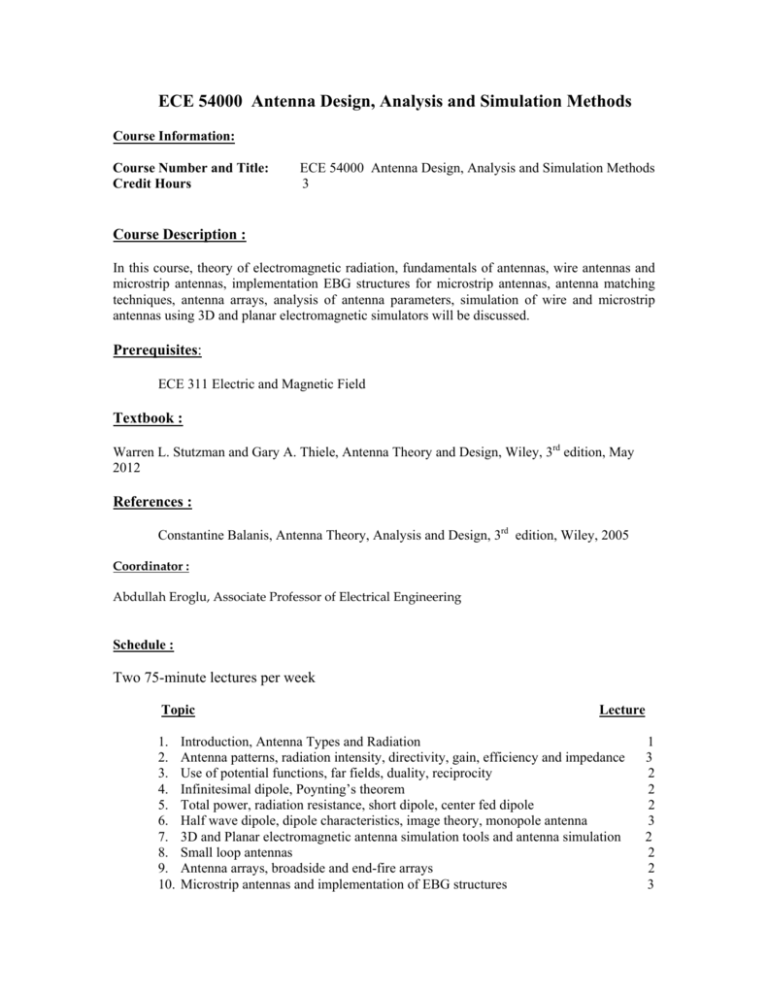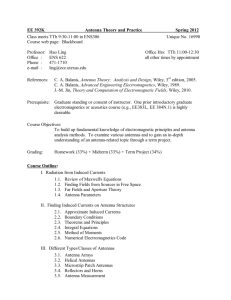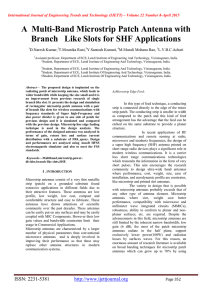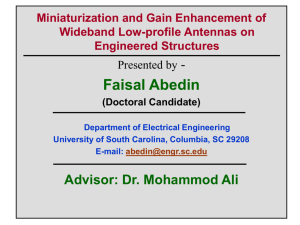ECE 54000 Antenna Design, Analysis and Simulation
advertisement

ECE 54000 Antenna Design, Analysis and Simulation Methods Course Information: Course Number and Title: Credit Hours ECE 54000 Antenna Design, Analysis and Simulation Methods 3 Course Description : In this course, theory of electromagnetic radiation, fundamentals of antennas, wire antennas and microstrip antennas, implementation EBG structures for microstrip antennas, antenna matching techniques, antenna arrays, analysis of antenna parameters, simulation of wire and microstrip antennas using 3D and planar electromagnetic simulators will be discussed. Prerequisites: ECE 311 Electric and Magnetic Field Textbook : Warren L. Stutzman and Gary A. Thiele, Antenna Theory and Design, Wiley, 3rd edition, May 2012 References : Constantine Balanis, Antenna Theory, Analysis and Design, 3rd edition, Wiley, 2005 Coordinator : Abdullah Eroglu, Associate Professor of Electrical Engineering Schedule : Two 75-minute lectures per week Topic 1. 2. 3. 4. 5. 6. 7. 8. 9. 10. Lecture Introduction, Antenna Types and Radiation Antenna patterns, radiation intensity, directivity, gain, efficiency and impedance Use of potential functions, far fields, duality, reciprocity Infinitesimal dipole, Poynting’s theorem Total power, radiation resistance, short dipole, center fed dipole Half wave dipole, dipole characteristics, image theory, monopole antenna 3D and Planar electromagnetic antenna simulation tools and antenna simulation Small loop antennas Antenna arrays, broadside and end-fire arrays Microstrip antennas and implementation of EBG structures 1 3 2 2 2 3 2 2 2 3 11. Antenna matching techniques 12. Reviews 13. Exams 3 2 2 Grading Distribution: Homework: Midterm Exam : Final Exam: Project : 20% 25% 25% 30% Grading Scale : 93-100 % =A 90-92 % = A87-89 % = B+ 83-86 % = B 80-82 % = B77-79 % = C+ 73-76 % = C 70-72 % = C60-69 % = D < 60% = F Course Objectives : To have fundamental understanding of electromagnetic radiation, antenna parameters such as radiation patterns, directivity, gain, impedance, wire antennas and microstrip antennas, EBG structures and their implementation, Poynting’s theorem, image theory and reciprocity, antenna matching techniques. In addition, students are expected to be able to simulate wire and microstrip antennas using 3D and planar electromagnetic simulators. Course Outcomes : A student who successfully fulfills the course requirements will have demonstrated: 1. 2. 3. 4. 5. 6. 7. an understanding of antenna parameters an understanding of electromagnetic radiation a basic knowledge of wire antennas a basic knowledge of microstrip antennas a basic knowledge of EBG structures a basic knowledge of antenna matching techniques an ability to use electromagnetic simulators in antenna design ABET Category: Engineering science: 2 credits or 75% Engineering design project: 1 credits or 25% Course Policies: Homework: Homework is due before the start of the following class one week after it’s assigned. Credit for late homework will diminish at the rate of 10% per day. Attendance: Regular attendance is critical for the successful completion of the course work. Attendance will be recorded. Student Dishonesty: Student dishonesty (cheating or plagiarizing) will not be tolerated. Students are encouraged to inform their academic advisors of instances of cheating or plagiarizing. Plagiarism is another form of cheating. Students are guilty of plagiarism when they present someone else’s work as their own. Examples are: asking a friend to write an assignment paper for you, or including portions of material from a books, journal, or computer file, without giving appropriate credit to the author. Penalties for student dishonesty can include a grade of “F” in the course. However, if a student believes she/he has been unjustly accused of dishonesty, he or she may follow the Grade Appeal Procedure to request a review of the case. Policy Concerning Students with Disabilities: If you have a disability and need assistance, special arrangements can be made to accommodate most needs. Contact the Director of Services for Students with Disabilities (Walb Union, Room 113, telephone number 481-6658) as soon as possible to work out the details. Once the Director has provided you with a letter attesting to your needs for modification, bring the letter to me. For more information, please visit the web site for SSD at http://www.ipfw.edu/ssd/.
![EEE 443 Antennas for Wireless Communications (3) [S]](http://s3.studylib.net/store/data/008888255_1-6e942a081653d05c33fa53deefb4441a-300x300.png)




